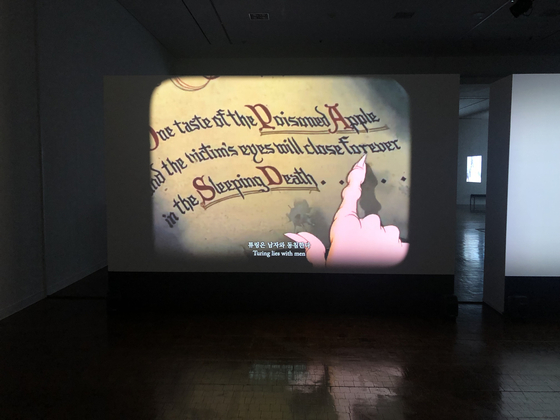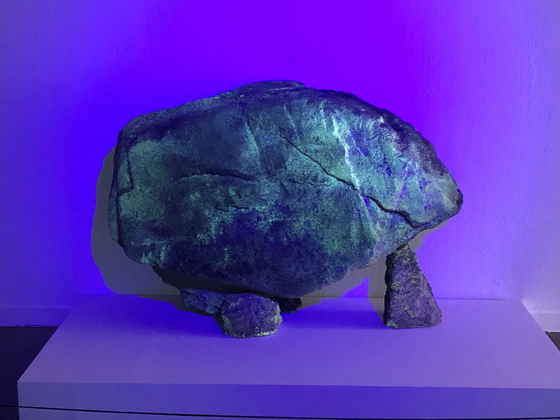The multiple layers of artist Song Sang-hee
![Artist Song Sang-hee [SONG SANG-HEE]](https://koreajoongangdaily.joins.com/data/photo/2022/02/07/e7d2ae7d-f2a6-4625-a088-d310a1b2ee2e.jpg)
Artist Song Sang-hee [SONG SANG-HEE]
“Homo Natura” is an enigmatic term introduced in Friedrich Nietzsche’s (1844-1900) book “Beyond Good and Evil” (1886), which explores the German philosopher’s understanding of the relationship between nature and human beings.
Using this motif, 52-year-old artist Song Sang-hee has manifested a more delicate, elaborate narrative which critics liken to a quilt of multiple layers.
Her solo exhibition “Homo Natura” is currently being held at the Seoul Museum of Art (SeMA) in Jung District, central Seoul.
Song is based in Amsterdam and utilizes numerous art forms like media, music, sketches, texts and performances. She was awarded the Korea Art Prize 2017, hosted by the National Museum of Modern and Contemporary Art (MMCA) that showcases the works of four selected artists every year, and the Hermès Foundation Missulsang in 2008, an annual award recognizing emerging Korean artists.
In “Homo Natura,” Song acknowledges the complexity and subtlety of human nature through seven pieces — “Apple” (2021), “The Song of the Earth” (2021), “Dream” (2021), “Geegers, You and I” (2018), “The New World” (2021), “On My Shoulder” (2021) and “Talk to You” (2021).
The Korea JoongAng Daily met with Song on Jan. 27 to talk about “Homo Natura” and her views on life.
“When I think of myself, there’s always something [inside] that discomforts me,” Song said. “I feel like there are numerous voices inside my head that are intertwined in different situations.”
Song wanted to find the answer to such perplexity. After searching through books she came upon Nietzsche, which influenced her to come up with “Homo Natura.”
“There are so many layers to life. A single person may be a bully to someone, yet at the same time be a victim to others. I wanted this exhibition to look deeply into the matter.”

![As part of “Apple” (2021), Song coordinated British mathematician Alan Turing’s biography “The Enigma” with the Disney animated film “Snow White and the Seven Dwarfs.″ [SHIN MIN-HEE]](https://koreajoongangdaily.joins.com/data/photo/2022/02/07/621a7294-6e96-486b-a5f4-1855a225d0f4.jpg)
As part of “Apple” (2021), Song coordinated British mathematician Alan Turing’s biography “The Enigma” with the Disney animated film “Snow White and the Seven Dwarfs.″ [SHIN MIN-HEE]
“Apple”
Media works like “Apple” and “Geegers, You and I” make reference to sources from historical events and literature, and most of Song’s works incorporate them into her artworks, forming her own narrative.
When asked if she is a bookworm, Song laughed, but shook her head.
“I tend to remember pretty much everything I see [or read],” Song said. “They get tattooed in my mind and I bring them up again later on.”
In one of the videos for the three-channel video “Apple,” Song coordinated British mathematician Alan Turing’s biography “The Enigma” (1983) with the Disney animated film “Snow White and the Seven Dwarfs” (1937). Turing is highly regarded to have contributed to the development of theoretical computer science and to have led the allies to victory in World War II after cracking the Germans’ coded messages. However, he suffered severely throughout his life as he was forced to undergo chemical castration for committing homosexual acts which were illegal at the time.
Although at a glance Turing and Snow White seem to have no correlation, the mathematician actually died from eating a poisoned apple. Song used the poisonous apple in “Snow White” as a metaphor: Just like how Snow White came back to life even after eating the apple, in present day Turing is also being re-evaluated and finally gaining back the recognition he deserves for his achievements.
“In 2015, I was working on a different piece and had to use Morse code,” Song said. “That was when I read the biography [‘The Enigma’] and I just couldn’t get over it. Years later, it kept spiraling inside my head which is why I ended up linking the two together.”
With this metaphor, Song intends to show that good and evil can be defined differently based on perspectives and time.
![The seven-channel video installation “The Song of the Earth” (2021) tells the story of each location’s historical pains. [SEOUL MUSEUM OF ART]](https://koreajoongangdaily.joins.com/data/photo/2022/02/07/3cd22498-107e-49d6-9581-bbcf55835d1b.jpg)
The seven-channel video installation “The Song of the Earth” (2021) tells the story of each location’s historical pains. [SEOUL MUSEUM OF ART]
“The Song of the Earth”
The seven-channel video installation “The Song of the Earth” may seem like a trajectory of a trip to the tropics or a forest, but it actually tells the story of each location’s historical pains. Song visited places including the ghost town of Chernobyl, Ukraine; Taean County, South Chungcheong where Korea’s worst oil spill ever happened in 2007; and Bagamoyo, Tanzania which served as a trading port for slaves from the 16th to 19th century.
Song said the trips were something she “simply had to do.”
“I started filming these places in 2008, right after the major oil spill in Taean County,” Song said. “I went to Taean, and I wanted to get footage from a fish’s perspective, so I made a boat-shaped camera and set it afloat on the sea.
![Song attached a camera to a long stick to film from the perspective of the birds that live in the mango trees in Tanzania. [SONG SANG-HEE]](https://koreajoongangdaily.joins.com/data/photo/2022/02/07/7349df0b-3a7c-4398-a812-62a0573e18b2.jpg)
Song attached a camera to a long stick to film from the perspective of the birds that live in the mango trees in Tanzania. [SONG SANG-HEE]
“As for Tanzania, I read in a book that the mango trees are a potent symbol of the slave trade. I attached a camera to a long stick to film from the perspective of the birds that live in the mango trees. I tried to capture the natural situations during my time there instead of focusing on specific things.”
When asked which location was the most memorable, Song said that a specific place doesn't come to mind as she gets mixed feelings whenever she watches the footage. Each location elicits a different feeling.
“But I remember feeling particularly drained during my stay in Africa. I wasn’t sad or anything — I just felt like I had too much on my mind. I went there for a reason, but [Africa] was completely different from what I had imagined. I actually went alone. I had trouble communicating with the people there. I went there to finish something, yet at the same time I wondered, ‘what do I know about slave trade?’ And the way the people treated me and the scorching weather — it was all very complicated.”
![In ″Dream″ (2021), glowing children’s clothes and asteroids dubbed “electronic bugs” are highlighted at Guui Station’s subway platform at night. [SEOUL MUSEUM OF ART]](https://koreajoongangdaily.joins.com/data/photo/2022/02/07/646bcaf4-d30d-4184-a003-e50016177d33.jpg)
In ″Dream″ (2021), glowing children’s clothes and asteroids dubbed “electronic bugs” are highlighted at Guui Station’s subway platform at night. [SEOUL MUSEUM OF ART]
“Dream”
In “Dream,” a single-channel video running for about 15 minutes, Song stands at the end of time. Instead of looking back at the past in chronological order, however, time is distorted, featuring objects as random as white square pillars the size of high-rise buildings that emerge along streams in Seoul.
“Time flows like a straight line, from past, present to future, but we never necessarily recall our memories in order,” Song said. “Sometimes we remember some memories more profoundly than others. Time is relative and very individualistic.”
Other scenes from “Dream” feature a weatherman forecasting bright, sunny weather during a bleak tour of a cramped low-cost accommodation, and glowing children’s clothes and asteroids dubbed “electronic bugs” are highlighted at Guui Station’s subway platform at night.
“It tells the story of being in a dream, where the timeline is tangled up. I’m standing at the edge of time. It’s about everything I’ve always wanted to say — whether it be guilt or grief — like when I think of children, I’m heartbroken. I’ve never been a mother, so I’m cautious about directly bringing up the subject. I wanted these objects to appear like hallucinations.”

![The ″asteroid″ featured in the subway station scene in ″Dream″ is also on display at the Seoul Museum of Art, with a tablet next to it, showing a fake text message conversation. [SHIN MIN-HEE]](https://koreajoongangdaily.joins.com/data/photo/2022/02/07/bd8ff4f4-5b7d-40ab-bbd7-75bcf699b56c.jpg)
The ″asteroid″ featured in the subway station scene in ″Dream″ is also on display at the Seoul Museum of Art, with a tablet next to it, showing a fake text message conversation. [SHIN MIN-HEE]
As part of “Dream,” some tablet PCs are also on display for visitors to see, showing text message conversations between two imaginary people. The conversations give possible explanations to “Dream.”
“I was thinking of a way I could add descriptions to my pieces, and since everyone is on KakaoTalk I made a fake conversation so it would be legible,” Song said. “But some people told me that they thought it was weird. Usually we try to avoid peeping at other people’s private messages so apparently they felt like they were being voyeuristic! This is why I love art. It helps me open my eyes to things I hadn’t thought about before.”
![The spinning speaker drones and a large single-screen engage in a simple yet dry conversation of the existence of “you” and “I″ in ″Talk to You″ (2021). [SEOUL MUSEUM OF ART]](https://koreajoongangdaily.joins.com/data/photo/2022/02/07/c08ed6e5-8e25-474a-aa0b-9202127c5351.jpg)
The spinning speaker drones and a large single-screen engage in a simple yet dry conversation of the existence of “you” and “I″ in ″Talk to You″ (2021). [SEOUL MUSEUM OF ART]
“Talk to You”
When the spinning drone speakers in “Talk to You” ask visitors who they are, it makes them hesitant to respond. A large single-channel video answers with numerous responses like “I am the mother of that child” and “I am that person that you hurt.” The entire piece engages in a simple yet dry conversation of the existence of “you” and “I.”
“This question [of who we are] is hard to answer because it’s difficult to define who you are,” Song said. “I live in Amsterdam, and if someone asks who I am, I am reluctant to respond. I could easily say that I am a middle-aged woman, but there is so much context behind my identity that would be omitted [with that response]. Not only that, when two people fight you must listen to both sides. Sometimes you can’t just conclude who is a victim or perpetrator.”
Though only an hour had passed during the interview, the depth of Song’s stories seem to encompass months’ or even years’ worth of introspection.
When asked what sort of attitude humans should have in life, Song paused for a few seconds, trying to recollect her thoughts.
“I tend to be vague,” Song started. “I’ve always thought that as a person, I’m inadequate, so who am I to get angry at or expect something from other people? Nothing is ever really completely bad or good. But these days, society has become extremely biased, as if that’s the only available option. We should be open to the chance of error and accept that sometimes we can be wrong, or agree to disagree. Only in that way can we truly respect one another.”
![Song in Tanzania in 2012 [SONG SANG-HEE]](https://koreajoongangdaily.joins.com/data/photo/2022/02/07/c5c43548-4889-410a-93a5-95095d5b866e.jpg)
Song in Tanzania in 2012 [SONG SANG-HEE]
“Homo Natura” ends Feb. 27. Admission is free. SeMA is open every day except Mondays. On weekdays, exhibitions are open from 10 a.m. to 8 p.m. On weekends and national holidays, SeMA is open until 6 p.m. until February. For more information, visit the official website sema.seoul.go.kr.
BY SHIN MIN-HEE [shin.minhee@joongang.co.kr]










with the Korea JoongAng Daily
To write comments, please log in to one of the accounts.
Standards Board Policy (0/250자)